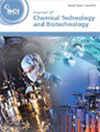One-pot green approach for rapid and effective anionic dye remediation: encapsulation within alginate nanocapsules
Abstract
BACKGROUND
The encapsulation technique was applied to efficiently eliminate Congo red (CR) from aqueous solutions. During the ionotropic gelation between calcium (Ca2+) ions and alginate (AL), CR was effectively entrapped within the AL nanocapsules in a one-step process. Suitable conditions for efficient CR removal via encapsulation were revealed by the systematic optimization of parameters including pH, time and stirring speed, etc.
RESULTS
According to the experimental observations, the stirring rate and temperature were found to have an insignificant effect on the encapsulation of CR molecules. When the pH value of the medium was 3, the highest level of encapsulation efficiency was achieved in a period of 15 min. At a preliminary CR concentration of 2000 mg L−1 and pH 3, the encapsulation efficiency was calculated at ≈98.9%, with an encapsulation capacity of 2800 mg dye g−1 AL. The zeta potential values of AL and CR/AL nanocapsules were determined to be +7.05 eV and −14.9 eV, respectively, and the results showed that the particles tended to agglomerate. TEM micrographs also showed that the nanocapsules were nanosized and agglomerated. Soil and UV degradation studies showed that the dye-entrapped nanocapsules degraded remarkably. These results highlighted the great potential of encapsulation for dye removal in economical and practical applications.
CONCLUSION
Encapsulation was confirmed to be an economical and practical technique for effectively eliminating CR from aqueous solutions. Under UV light irradiation, the dye molecules entrapped within alginate nanocapsules displayed photodegradation. © 2024 Society of Chemical Industry (SCI).

 求助内容:
求助内容: 应助结果提醒方式:
应助结果提醒方式:


